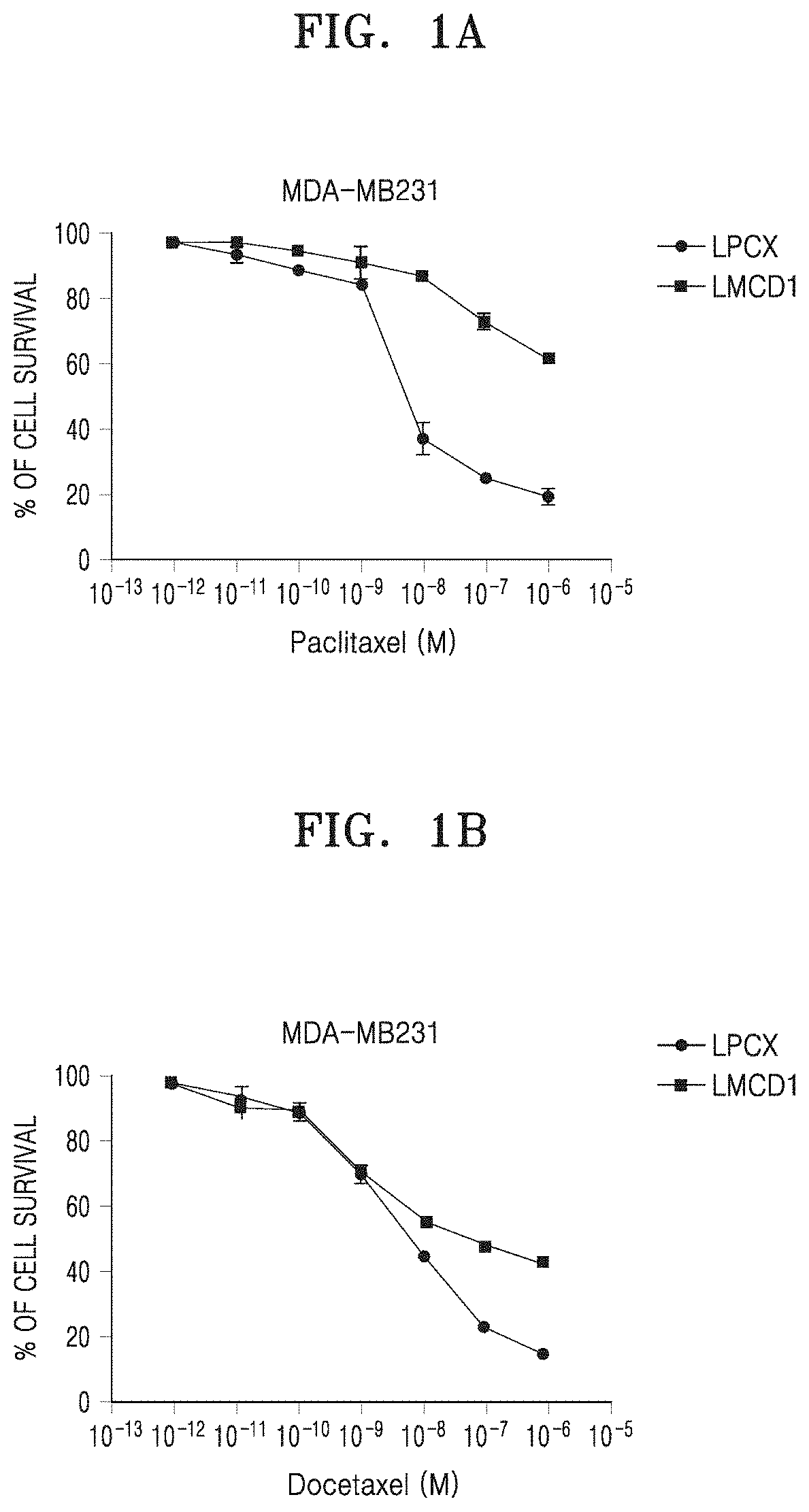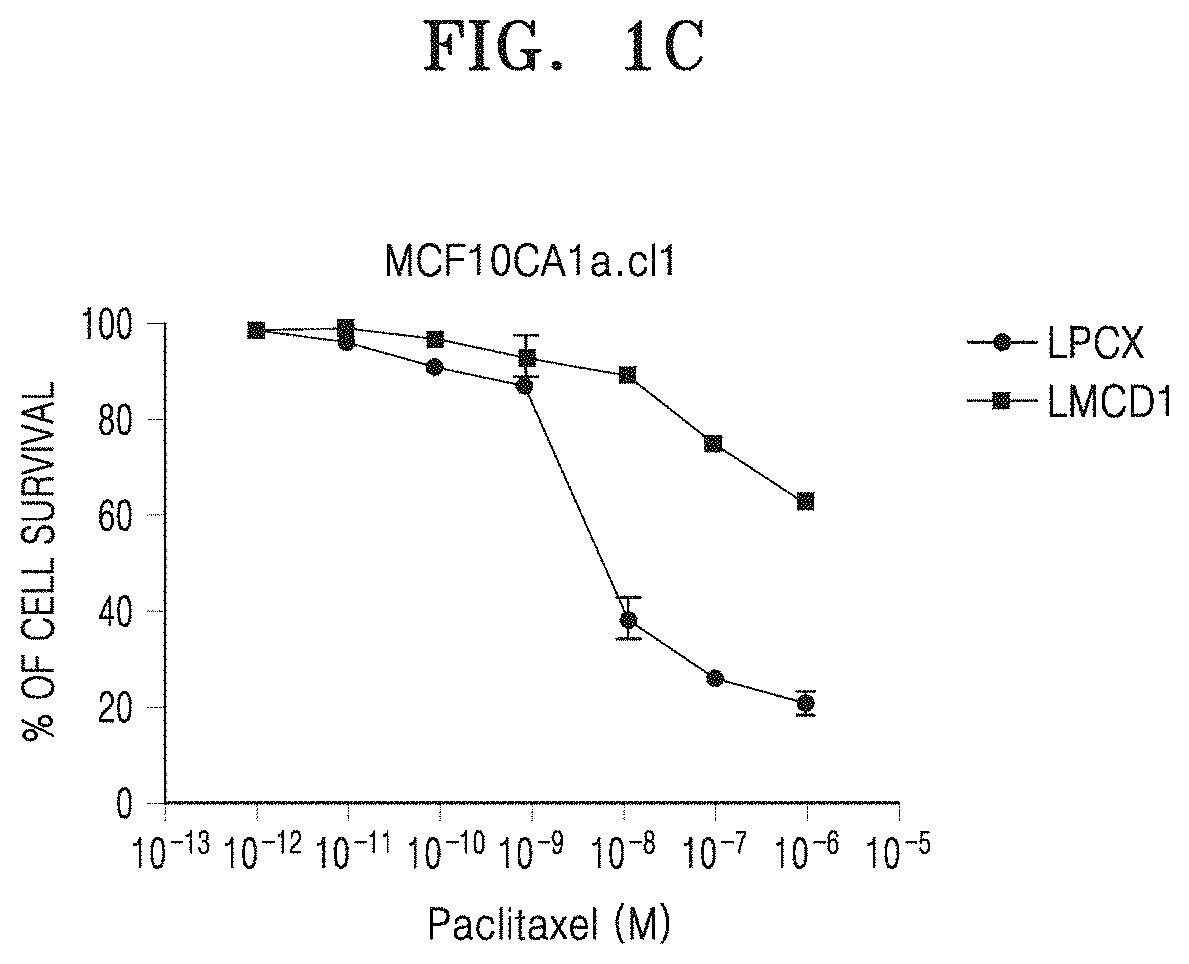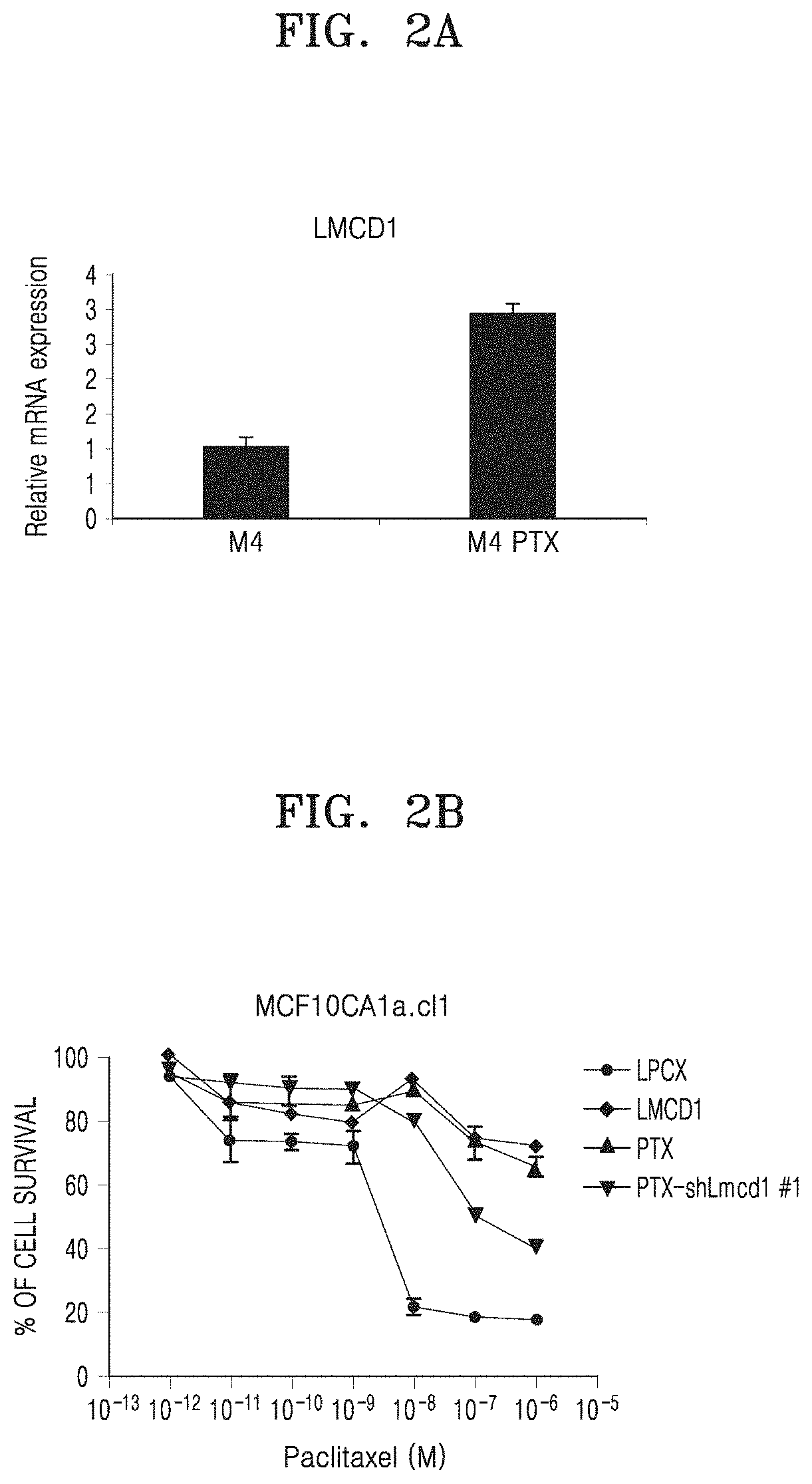Method for diagnosis of metastatic cancer or taxane-based drug-resistant cancer by using lmcd1 protein and gene coding therefor
a technology of metastatic cancer and gene coding, which is applied in the direction of instruments, drug compositions, peptides, etc., can solve the problems of paclitaxel-resistant breast cancer patients who frequently experience recurrence and metastasis, and the therapeutic prognosis is deteriorated, and achieves convenient and convenient selection, unnecessary drug treatment, and enhanced cancer therapeutic efficiency
- Summary
- Abstract
- Description
- Claims
- Application Information
AI Technical Summary
Benefits of technology
Problems solved by technology
Method used
Image
Examples
example 1
ion of Resistance to Taxane-Based Anticancer Agent in LMCD1-Overexpressing Cells Through MTT Assay
[0063]To investigate whether LMCD1 protein-overexpressing breast cancer cells have resistance to a taxane-based anticancer agent, an MTT assay, which is used to evaluate cell viability, was performed on MCF-10CA1a.cl1, which are human MCF-10A-based breast cancer cell lines, and MDA-MB231. The MCF-10CA1a.cl1 and MDA-MB231 cell lines are characterized as malignant breast cancer cell lines with high metastasis.
[0064]In particular, human MCF-10A-based breast cancer cell lines, i.e., MCF-10CA1a.cl1 and MDA-MB231, were maintained in a DMEM culture solution containing 10% fetal bovine serum and 1% penicillin / streptomycin (WeIGENE) in a CO2 incubator at 37° C.
[0065]To overexpress the LMCD1 protein in cells, LMCD1 was cloned into retroviral vector pLPCX, and LMCD1 retrovirus was obtained using Plat-GP cells. The metastatic breast cancer cells were infected with the LMCD1 retrovirus, LMCD1 protei...
example 2
n of LMCD1 Overexpression in Cells with Resistance to Taxane-Based Anticancer Agent
[0068]2-1. Production of Cells with Resistance to Taxane-Based Anticancer Agent
[0069]To evaluate whether the LMCD1 protein is overexpressed in cells having resistance to a taxane-based anticancer agent, cells having resistance to a taxane-based anticancer agent were produced.
[0070]In particular, parental cells were treated with paclitaxel at a small concentration of 0.5 nM, and alive cells were repeated treated with paclitaxel three or four times while being passaged. After the repeated paclitaxel treatment processes, alive cells were treated with paclitaxel with an increment of 0.5 nM, and then passaging of alive cells was further repeated, thereby producing cells having resistance to paclitaxel that did not die even at an IC50 value of 50 nM.
[0071]2.2. Evaluation of LMCD1 Expression Level in Cells with Resistance to Taxane-Based Anticancer Agent
[0072]An expression level of LMCD1 in taxane-based anti...
example 3
ion of LMCD1 Overexpression and the Effect of Different Smad3 Protein Phosphorylation in Paclitaxel-Resistant Cells
[0080]3-1. Production of Smad3 Phosphorylation Inhibition Model
[0081]To verify whether LMCD1 overexpression and Smad3 linker phosphorylation inhibition are exhibited in paclitaxel-resistant cells, as illustrated in FIGS. 3A-3C, phosphorylation inhibition models according to Smad3 phosphorylation site were produced. GFP, Smad3 wild-type, C-terminal phosphorylation-inhibiting mutant (3SA), Smad3 linker phosphorylation-activating mutant (STD), and a Smad3 linker phosphorylation-inhibiting mutant (EPSM) adenovirus were supplied from Dr. Sushil G. Rane (NIDDK, NIH, Bethesda, Md.). To measure transduction efficiency, GFP adenovirus was used as a control. The cells were transfected with 75 to 100 virus particles / cell in a cell solution, and each transfection procedure was repeated three times.
[0082]3-2. Evaluation of LMCD1 Expression Level and Smad3 Protein Phosphorylation in ...
PUM
| Property | Measurement | Unit |
|---|---|---|
| volume | aaaaa | aaaaa |
| pH | aaaaa | aaaaa |
| temperature | aaaaa | aaaaa |
Abstract
Description
Claims
Application Information
 Login to View More
Login to View More - R&D
- Intellectual Property
- Life Sciences
- Materials
- Tech Scout
- Unparalleled Data Quality
- Higher Quality Content
- 60% Fewer Hallucinations
Browse by: Latest US Patents, China's latest patents, Technical Efficacy Thesaurus, Application Domain, Technology Topic, Popular Technical Reports.
© 2025 PatSnap. All rights reserved.Legal|Privacy policy|Modern Slavery Act Transparency Statement|Sitemap|About US| Contact US: help@patsnap.com



